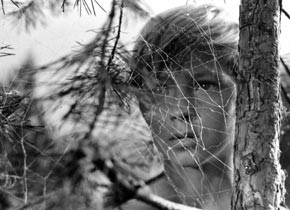Andrei Tarkovsky
March 5 to 25, 2009
Andrei Tarkovsky is one of the few cinema greats whose mere name evokes a whole world of ideas, even for people who have never seen any of his films. Those who retain a certain distance towards cinema welcome his work as an exception – a rare case of film as high art. Yet, Tarkovsky “works” for many different constituencies: for mystics as well as for formalists; for the educated classes who see in him the heir to the 19th-Century Russian literary tradition; for people who've opted out of the rat-race of mainstream society and thus respond to Tarkovsky's pilgrim characters; or for generations of teenagers, who are shattered by their first encounters with a fully interiorized type of science-fiction cinema (Stalker, 1979; Solaris, 1972).
He was also a case for Bresson, Bergman and Kurosawa, who admired his work as deeply as he did theirs, and for composers, who have paid their respects to him in the field of pop (Björk), ambient (Robert Rich), or Contemporary Classical Music (Luigi Nono, Toru Takemitsu); a case for Jean-Paul Sartre (who defended Tarkovsky's début Ivan's Childhood [1962] in a fiery letter against attacks from the Italian left) and for numerous artists who have orbited his work with videos and installations in recent years. The diversity of this pan-cultural canonization, however, offers no protection from a real danger – that Tarkovsky's oeuvre becomes frozen into a cliché: the sacred in cinematic form.
This danger can only be averted by again embarking on an encounter with his films. His output is slim: seven feature films made between 1962 and 1986; a documentary essay which he shot in 1983 together with the Italian author Tonino Guerra while working on Nostalghia (1983); and three short to medium-length films made while at university. The portrait films about Tarkovsky, which the Austrian Film Museum will be showing in the course of this Retrospective (including those by Chris Marker and Aleksandr Sokurov), are helpful, too – not only for the information they hold, but also as examples of the multiple ways in which Tarkovsky has been painted as an icon.
He was born in 1932 the son of the poet Arseni Tarkovsky, but grew up with his mother Maria Vishnaykova. His father's works are often quoted in his films, most extensively in the autobiographical masterwork The Mirror (1975) which is itself structured like a poem (and which places the figure of the mother at the centre). After studying Asian languages and participating in a geological expedition, Tarkovsky inscribed at the VGIK, the Moscow Film School, in 1955. Amongst his heroes in those days were the Neo-Realists and Henri-Georges Clouzot; he was also fascinated by the expressive imagery in the works of Mikhail Kalatozov (The Cranes Are Flying). His own signature style of time-flow units and glacial long takes developed only gradually; it wasn't until the second half of his creative life that they became the defining measure of his art.
Tarkovsky's problems with the authorities already started with his thesis film at the VGIK, The Steamroller and the Violin (1961), which was imbued with scepticism towards power and authority. With the exception of Solaris, he had to battle with domestic cultural conservatives over all of his works; by the time of Nostalghia (1983), it had become too much for him to deal with. When shooting in Italy was completed, he chose not to return to the Soviet Union. Thereafter Tarkovsky commuted between Milan, London, West Berlin, Sweden (where his last film, The Sacrifice, was shot), and Paris, where he died in December, 1986, a victim of lung cancer.
The other side of Tarkovsky's relationship to the USSR was hardly perceived in the West: He saw himself as a Soviet filmmaker and a professional in his métier; he wrote screenplays for genre films on the side, taught at the VGIK and took part in the everyday affairs of his studio. His first feature came about by accident: someone else had begun Ivan's Childhood and had not come to grips with the production. To help out the studio, Tarkovsky stepped in and completed the project, on time and within the budget. Tarkovsky's films aren't just the meditations of a "shaman" on things eternal; he also proved that he was a man of his times. Andrey Rublyov (1966-69), for instance, is a typical if slightly belated work of the Soviet "thaw" period.
When all is said and done, it was not so much the spiritual element per se which made the Soviet functionaries so nervous regarding his films, but the premonition that the religious core of Soviet Communism was crystallizing in his works. Enlightened, progressive intellectuals in the West must come to terms with similar contradictions: with Andrei Tarkovsky, they are confronted with an apocalypticist who knew how to celebrate the four elements of nature like no other filmmaker. Sceptical towards rationalism and language, he campaigned eloquently against the avant-garde, yet ranks amongst the most advanced artists of the 20th Century in his shaping of forms. An anti-modernist axiom of modernism.
Thanks to the support of the Russian Cultural Institute, three of Tarkovsky's key "accomplices" will be present at the Filmmuseum for the show's opening. These are Nikolay Burlyaev (lead actor in "Ivan's Childhood" amongst other roles), the actor Yuri Nazarov and the great cinematographer Vadim Yusov, who was responsible for the visual style of Tarkovsky's films up to and including "Solaris".
The Retrospective has been organized in collaboration with VGIK, the Moscow Film School, which celebrates its 90th anniversary in 2009.
Related materials
